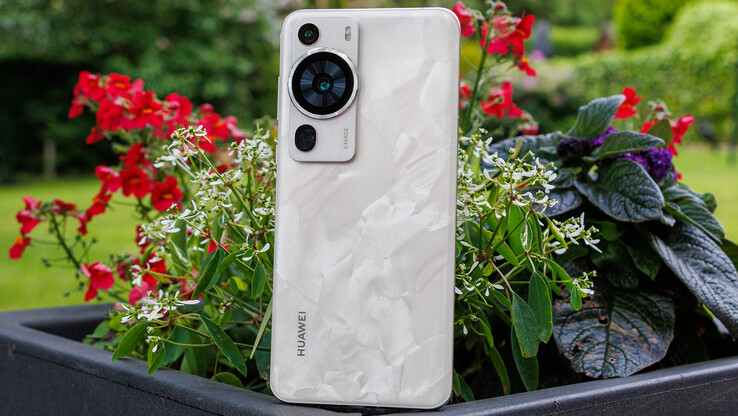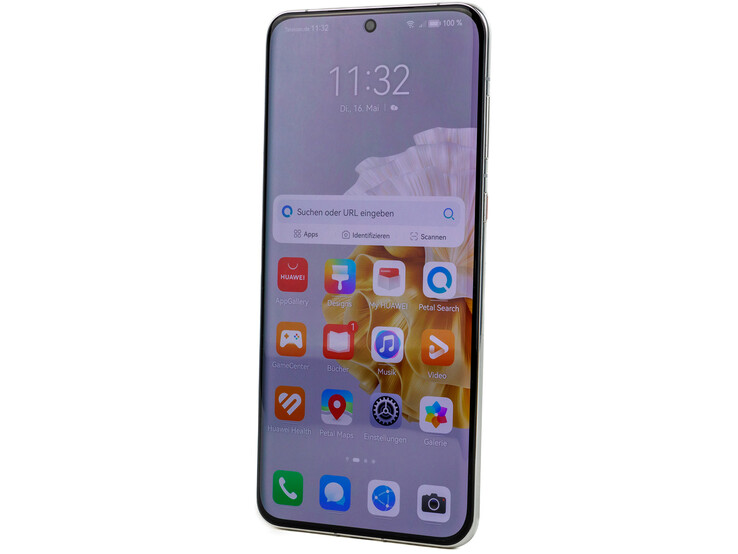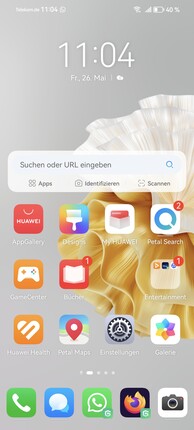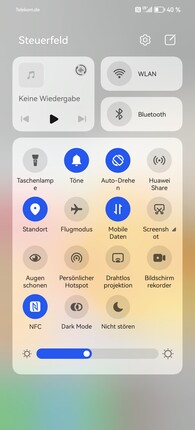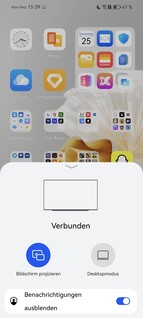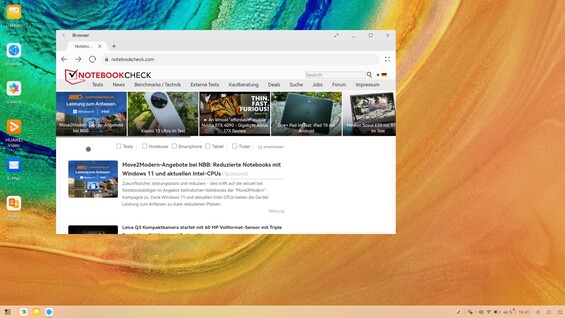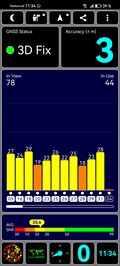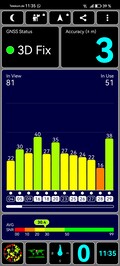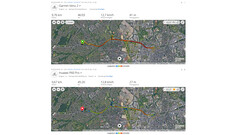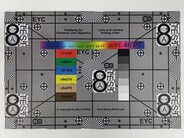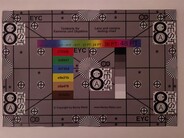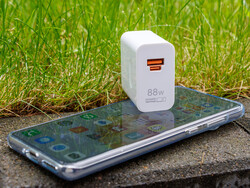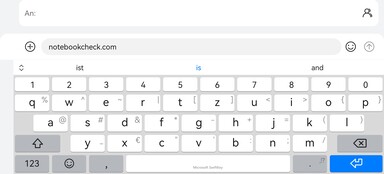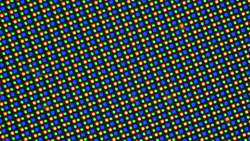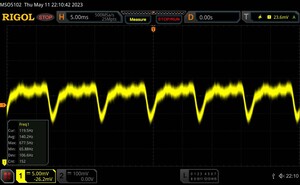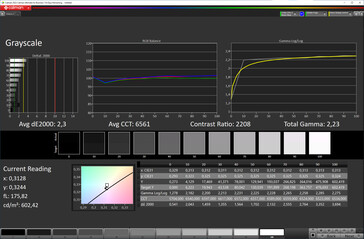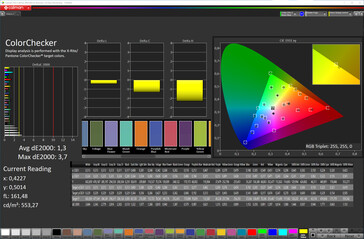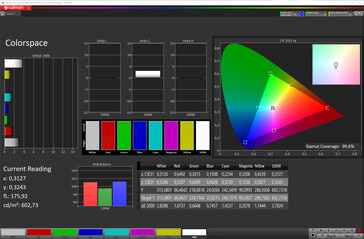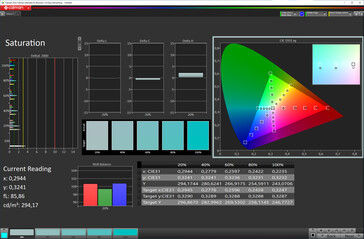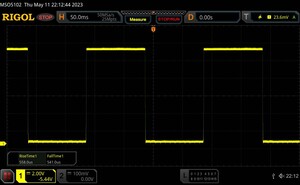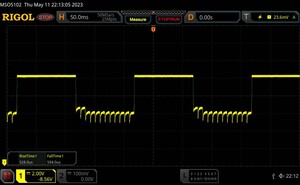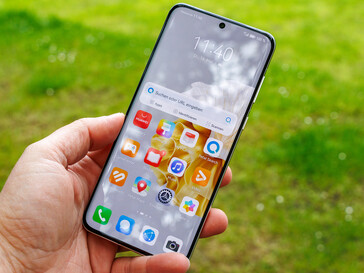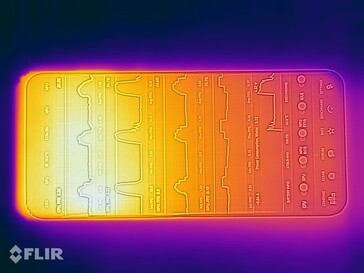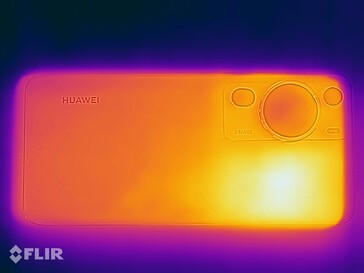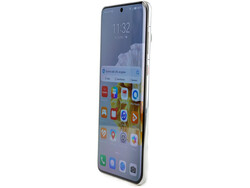华为P60 Pro评测--即使没有徕卡也是一款强大的相机智能手机
潜在的竞争对手比较
Rating | Date | Model | Weight | Drive | Size | Resolution | Price |
|---|---|---|---|---|---|---|---|
| 88.8 % v7 (old) | 06 / 2023 | Huawei P60 Pro SD 8+ Gen 1, Adreno 730 | 200 g | 256 GB UFS 3.1 Flash | 6.67" | 2700x1220 | |
| 91.1 % v7 (old) | 03 / 2023 | Samsung Galaxy S23 Ultra SD 8 Gen 2 for Galaxy, Adreno 740 | 233 g | 256 GB UFS 4.0 Flash | 6.80" | 3080x1440 | |
| 90.3 % v7 (old) | 01 / 2023 | Apple iPhone 14 Pro A16, A16 GPU 5-Core | 206 g | 256 GB NVMe | 6.10" | 2556x1179 | |
| 89.2 % v7 (old) | 03 / 2023 | Xiaomi 13 Pro SD 8 Gen 2, Adreno 740 | 229 g | 256 GB UFS 4.0 Flash | 6.73" | 3200x1440 | |
| 90.1 % v7 (old) | 07 / 2023 | Honor Magic5 Pro SD 8 Gen 2, Adreno 740 | 219 g | 512 GB UFS 4.0 Flash | 6.81" | 2848x1312 | |
| 89.1 % v7 (old) | 11 / 2022 | Google Pixel 7 Pro Tensor G2, Mali-G710 MP7 | 212 g | 128 GB UFS 3.1 Flash | 6.70" | 3120x1440 |
表壳 - 光滑的背面和昆仑玻璃
» Notebookcheck多媒体笔记本电脑Top 10排名
» Notebookcheck游戏笔记本电脑Top 10排名
» Notebookcheck低价办公/商务笔记本电脑Top 10排名
» Notebookcheck高端办公/商务笔记本电脑Top 10排名
» Notebookcheck工作站笔记本电脑Top 10排名
» Notebookcheck亚笔记本电脑Top 10排名
» Notebookcheck超级本产品Top 10排名
» Notebookcheck变形本产品Top 10排名
» Notebookcheck平板电脑Top 10排名
» Notebookcheck智能手机Top 10排名
» Notebookcheck评测过最出色的笔记本电脑屏幕
» Notebookcheck售价500欧元以下笔记本电脑Top 10排名
» Notebookcheck售价300欧元以下笔记本电脑Top 10排名
在亚洲之外,华为P60 Pro有黑色和洛可可珍珠色。紫色和绿色只在亚洲市场提供。我们的测试设备是洛可可珍珠色,并不完全是白色--相反,它有一种珠光的光泽,这对每部手机都是独一无二的。华为通过手工将矿物珠光粉涂在手机上--但是,这种技术没有进一步说明。这一特点不仅吸引人的眼球--而且拿在手里也是一种真正的快乐。
显示屏由昆仑玻璃保护--据说比普通玻璃强十倍。即便如此,这款手机还在上面安装了一个额外的屏幕保护膜。屏幕的四边都是弧形的--与在Honor Magic5 Pro 上已经看到的一样。这款手机的结构非常好--没有缝隙,结构也很光滑,除了我们的测试设备的背面和铝框之间有一个微小的缝隙。
华为P60 Pro获得了IP68认证,这意味着它可以防尘和防水。
连接性 - USB 3.2和一个快速的microSD读卡器
华为P60 Pro有一个快速的USB 3.2端口(Gen 1),可以实现高数据传输率。在我们的复制测试中,这个端口的平均传输速率达到368.49MB/s。你还可以用它来输出图片--你可以镜像屏幕或利用专门的 "桌面模式"。
除此以外,这款手机还有NFC、红外辐射器以及蓝牙5.2,但遗憾的是它没有音频插孔。
微型SD卡读卡器
华为手机采用了内部的NanoMemory卡插槽,支持高达256GB以及exFAT。在我们的复制测试中,它的传输速率同样很快--尽管,在我们的跨平台磁盘测试中,速率略低于预期。
| SD Card Reader - average JPG Copy Test (av. of 3 runs) | |
| Huawei P60 Pro (Huawei NanoMemory) | |
| Huawei P50 Pro (Huawei NanoMemory) | |
| Sony Xperia 1 IV (Angelbird AV Pro V60) | |
Cross Platform Disk Test (CPDT)
软件--P60 Pro继续错过谷歌服务
在欧洲,华为P60 Pro配备了EMUI 13.1,它是基于OpenAndroid 。在亚洲市场,这款手机使用的是Harmony OS 3.1,其构建方式并没有什么不同,看起来也差不多。华为没有提供任何关于更新交付的详细信息--在过去,它一直是体面的。在测试时,最新的安全补丁是2023年3月1日的--不是完全最新的。
与过去几年一样,P60 Pro继续缺少谷歌服务和相应的应用程序。如果你看一下华为的AppGallery,许多应用程序会很熟悉--但一些美国的大公司,如Meta、Netflix和Disney,却无处可寻。你可以使用Petal搜索功能,以便从其他平台下载这些应用程序,但对于技术不熟练的人来说,这似乎是一个巨大的麻烦。一个更好的选择可能是GBox,它很容易安装,并使Play Store可以使用--这意味着你也可以选择掌握许多谷歌服务。不幸的是,这可能会导致更高的电池消耗,而且在利用这一途径时,你必须对数据保护有一点警惕性。
通信和GNSS - 没有5G的华为智能手机
华为P60 Pro支持带有VHT160的Wi-Fi 6,这意味着它可以利用2.4和5.0GHz的频率--但不是6.0GHz。通过我们的参考路由器,即华硕ROG Rapture GT-AXE11000,连接很稳定--但速度落后于我们的预期。就手机的规格而言,我们本来期望速度超过1GBit/s。
使用移动数据,你能得到的最好的是LTE,但仍然没有5G。不过,其频率覆盖范围相当好,这意味着你可以在全球范围内使用这款手机。
| Networking | |
| Huawei P60 Pro | |
| iperf3 receive AXE11000 | |
| iperf3 transmit AXE11000 | |
| Samsung Galaxy S23 Ultra | |
| iperf3 receive AXE11000 | |
| iperf3 transmit AXE11000 | |
| iperf3 transmit AXE11000 6GHz | |
| iperf3 receive AXE11000 6GHz | |
| Apple iPhone 14 Pro | |
| iperf3 receive AXE11000 | |
| iperf3 transmit AXE11000 | |
| Xiaomi 13 Pro | |
| iperf3 receive AXE11000 | |
| iperf3 transmit AXE11000 | |
| iperf3 transmit AXE11000 6GHz | |
| iperf3 receive AXE11000 6GHz | |
| Honor Magic5 Pro | |
| iperf3 receive AXE11000 | |
| iperf3 transmit AXE11000 | |
| Google Pixel 7 Pro | |
| iperf3 receive AXE11000 | |
| iperf3 transmit AXE11000 | |
| iperf3 transmit AXE11000 6GHz | |
| iperf3 receive AXE11000 6GHz | |
| Huawei P50 Pro | |
| iperf3 receive AXE11000 | |
| iperf3 transmit AXE11000 | |
| Average of class Smartphone | |
| iperf3 receive AXE11000 | |
| iperf3 transmit AXE11000 | |
| iperf3 transmit AXE11000 6GHz | |
| iperf3 receive AXE11000 6GHz | |
华为P60 Pro是第一款支持GNSS频段E5b(伽利略)和B2b(北斗)的智能手机。通过卫星进行定位的速度很快,而且可以迅速确定精确的位置。
我们在一次自行车旅行中,将该手机与Garmin Venu 2 。在我们10公里长的旅程中,两台设备相隔90米使用--我们注意到,P60 Pro并不像健身智能手表那样能够准确追踪我们的路线,即使它有更广泛的GNSS支持。即便如此,它在一天结束时仍然做得很好。
电话功能和通话质量
华为P60 Pro支持VoLTE和WLAN通话等功能--SIP账户控制没有在系统中实现。
将手机举到耳边,通话质量非常好,较大的环境噪音被有效过滤掉了。扬声器模式也给人留下了良好的印象--虽然有时会有一点回声。
摄像机--P60 Pro少了一个镜头
华为P60 Pro的前置摄像头可以拍出很好的自拍,其可定制的虚化效果很好地区分了主体和背景之间的界限。
而P50 Pro有一个四摄像头,而P60 Pro则少了一个镜头,并完全摆脱了单色传感器。它的主摄像头以其平衡的照片给人留下了深刻印象--手机不会过度锐化主体,照片有很好的动态。低光拍照也是可以的,但它有时对主体的勾勒有点太刺眼了。P60 Pro还具有自动光圈控制功能,可以自动在f/1.4和f/4.0之间设置光圈。你可以通过专业模式手动控制这一功能--这一功能我们已经从Mate50 Pro.
这款智能手机的超广角镜头是较好的镜头之一,尽管它只能获得12MPix--它实现了可爱的景深和良好的细节水平。潜望镜相机不仅可以获得高分辨率,它也是非常感光的,光圈为f/2.1。它有一个100倍的数字变焦,但打不是完全最好的。从10倍左右的变焦开始,你已经开始注意到相当多的不足之处--尽管如此,对于社交媒体来说已经足够好。
只要你以16:9的格式拍摄,你就可以在前置摄像头和主摄像头上以最高的超高清和60FPS录制视频。如果你想以21:9的格式录制,你就只能以全高清(60 FPS)的方式录制。HDR视频可以使用所有的分辨率和格式来记录,然而,它们被限制在30 FPS。
利用不同级别变焦的照片
Image comparison
Choose a scene and navigate within the first image. One click changes the position on touchscreens. One click on the zoomed-in image opens the original in a new window. The first image shows the scaled photograph of the test device.
Main cameraMain cameraUltra-wide angle5x zoomLow light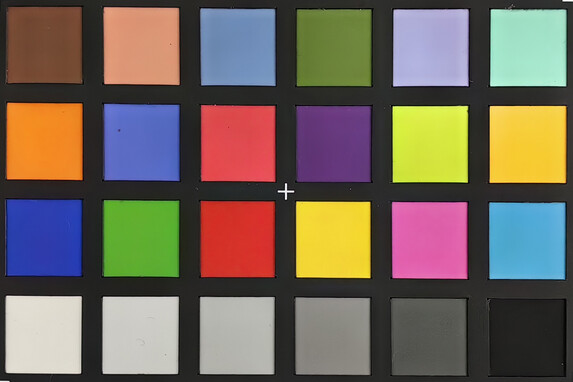
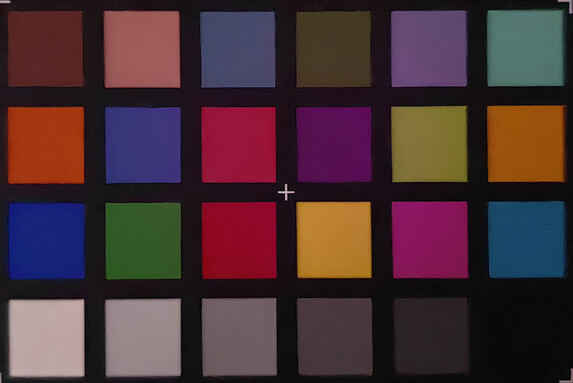
附件和保修 - 包括一个快速充电适配器
输入设备和操作 - P60 Pro有一个光学指纹传感器
显示屏 - 一个明亮的120-Hz OLED屏幕
华为P60 Pro的屏幕继续依靠LTPO OLED技术,扩大了全高清分辨率,使其具有极大的清晰度。它的刷新率由系统自动设置,范围在1至120赫兹之间。支持HDR标准HLG、HDR10和HDR10+。
与手机的前代产品相比,屏幕的亮度有了很大的提高,当屏幕为全白时,只要环境光传感器被激活,它的最大亮度为1,188cd/m²。在手动模式下,它能达到612cd/m²的比率。在光区和暗区均匀分布的情况下(APL18),这些比率几乎没有任何提高,为1,233 cd/m²。
P60 Pro的面板支持1,440赫兹的PWM调光,这应该可以大大减少敏感用户的压力。使用示波器,我们仍然能够测量到120赫兹的相对稳定的频率--尽管这可能是因为可能的屏幕烧毁保护或黑框插入。
| |||||||||||||||||||||||||
Brightness Distribution: 98 %
Center on Battery: 1188 cd/m²
Contrast: ∞:1 (Black: 0 cd/m²)
ΔE ColorChecker Calman: 1.3 | ∀{0.5-29.43 Ø4.78}
ΔE Greyscale Calman: 2.3 | ∀{0.09-98 Ø5}
99.6% sRGB (Calman 2D)
Gamma: 2.23
CCT: 6561 K
| Huawei P60 Pro OLED, 2700x1220, 6.7" | Samsung Galaxy S23 Ultra Dynamic AMOLED 2x, 3080x1440, 6.8" | Apple iPhone 14 Pro Super Retina XDR OLED, 2556x1179, 6.1" | Xiaomi 13 Pro OLED, 3200x1440, 6.7" | Honor Magic5 Pro OLED, 2848x1312, 6.8" | Google Pixel 7 Pro OLED, 3120x1440, 6.7" | Huawei P50 Pro OLED, 2700x1228, 6.6" | |
|---|---|---|---|---|---|---|---|
| Screen | -14% | 4% | 12% | -10% | 17% | -0% | |
| Brightness middle (cd/m²) | 1188 | 1117 -6% | 1046 -12% | 1230 4% | 1291 9% | 1022 -14% | 765 -36% |
| Brightness (cd/m²) | 1189 | 1133 -5% | 1049 -12% | 1244 5% | 1289 8% | 1025 -14% | 771 -35% |
| Brightness Distribution (%) | 98 | 97 -1% | 98 0% | 94 -4% | 96 -2% | 99 1% | 95 -3% |
| Black Level * (cd/m²) | |||||||
| Colorchecker dE 2000 * | 1.3 | 2.2 -69% | 1.2 8% | 1 23% | 1.7 -31% | 0.9 31% | 1.2 8% |
| Colorchecker dE 2000 max. * | 3.7 | 3.9 -5% | 3.1 16% | 2.8 24% | 4.4 -19% | 2.1 43% | 2.6 30% |
| Greyscale dE 2000 * | 2.3 | 2.3 -0% | 1.7 26% | 1.8 22% | 2.9 -26% | 1.1 52% | 1.5 35% |
| Gamma | 2.23 99% | 2.37 93% | 2.19 100% | 2.24 98% | 2.28 96% | 2.22 99% | 2.21 100% |
| CCT | 6561 99% | 6572 99% | 6538 99% | 6446 101% | 6472 100% | 6650 98% | 6446 101% |
* ... smaller is better
Screen Flickering / PWM (Pulse-Width Modulation)
| Screen flickering / PWM detected | 120 Hz | ||
The display backlight flickers at 120 Hz (worst case, e.g., utilizing PWM) . The frequency of 120 Hz is very low, so the flickering may cause eyestrain and headaches after extended use. In comparison: 53 % of all tested devices do not use PWM to dim the display. If PWM was detected, an average of 8111 (minimum: 5 - maximum: 343500) Hz was measured. | |||
测量系列具有固定的变焦水平和不同的亮度设置。
Display Response Times
| ↔ Response Time Black to White | ||
|---|---|---|
| 1.1 ms ... rise ↗ and fall ↘ combined | ↗ 0.558 ms rise | |
| ↘ 0.541 ms fall | ||
| The screen shows very fast response rates in our tests and should be very well suited for fast-paced gaming. In comparison, all tested devices range from 0.1 (minimum) to 240 (maximum) ms. » 4 % of all devices are better. This means that the measured response time is better than the average of all tested devices (20.2 ms). | ||
| ↔ Response Time 50% Grey to 80% Grey | ||
| 1.12 ms ... rise ↗ and fall ↘ combined | ↗ 0.528 ms rise | |
| ↘ 0.594 ms fall | ||
| The screen shows very fast response rates in our tests and should be very well suited for fast-paced gaming. In comparison, all tested devices range from 0.165 (minimum) to 636 (maximum) ms. » 4 % of all devices are better. This means that the measured response time is better than the average of all tested devices (31.6 ms). | ||
性能--华为智能手机配备快速的骁龙8+第一代处理器
华为P60 Pro依靠的是骁龙8+第一代4G配有8或12GB内存。与我们测试的拥有这种SoC的智能手机相比,它的纯CPU速度刚刚超过平均水平--但它显然输给了已经利用后续一代芯片组的手机。
它的UFS 3.1存储也非常快,在写小数据块时,可以与许多拥有UFS 4.0的竞争对手竞争。
| UL Procyon AI Inference for Android - Overall Score NNAPI | |
| Sony Xperia 1 IV | |
| Average Qualcomm Snapdragon 8+ Gen 1 (3291 - 84787, n=21) | |
| Google Pixel 7 Pro | |
| Average of class Smartphone (3769 - 81594, n=139, last 2 years) | |
| Samsung Galaxy S23 Ultra | |
| Xiaomi 13 Pro | |
| Huawei P60 Pro | |
| Honor Magic5 Pro | |
这款手机的集成阿德雷诺730在图形基准测试中给人留下了深刻的印象--然而,它的许多竞争对手的表现都超过了这个设备,因为他们已经使用了较新的Adreno 740.
在一天结束的时候,这款手机仍然有足够的能力来运行要求更高的游戏和应对其他复杂的图形计算。
GFXBench (DX / GLBenchmark) 2.7: T-Rex Onscreen | 1920x1080 T-Rex Offscreen
GFXBench 3.0: on screen Manhattan Onscreen OGL | 1920x1080 1080p Manhattan Offscreen
GFXBench 3.1: on screen Manhattan ES 3.1 Onscreen | 1920x1080 Manhattan ES 3.1 Offscreen
GFXBench: on screen Car Chase Onscreen | 1920x1080 Car Chase Offscreen | on screen Aztec Ruins High Tier Onscreen | 2560x1440 Aztec Ruins High Tier Offscreen | on screen Aztec Ruins Normal Tier Onscreen | 1920x1080 Aztec Ruins Normal Tier Offscreen | 3840x2160 4K Aztec Ruins High Tier Offscreen
| 3DMark / Wild Life Extreme Unlimited | |
| Samsung Galaxy S23 Ultra | |
| Xiaomi 13 Pro | |
| Honor Magic5 Pro | |
| Apple iPhone 14 Pro | |
| Huawei P60 Pro | |
| Google Pixel 7 Pro | |
| Huawei P50 Pro | |
| 3DMark / Wild Life Extreme | |
| Xiaomi 13 Pro | |
| Samsung Galaxy S23 Ultra | |
| Honor Magic5 Pro | |
| Apple iPhone 14 Pro | |
| Huawei P60 Pro | |
| Google Pixel 7 Pro | |
| Huawei P50 Pro | |
| 3DMark / Wild Life Unlimited Score | |
| Samsung Galaxy S23 Ultra | |
| Xiaomi 13 Pro | |
| Honor Magic5 Pro | |
| Apple iPhone 14 Pro | |
| Huawei P60 Pro | |
| Google Pixel 7 Pro | |
| Huawei P50 Pro | |
| 3DMark / Wild Life Score | |
| Google Pixel 7 Pro | |
| Huawei P50 Pro | |
| Honor Magic5 Pro | |
| 3DMark / Sling Shot Extreme (ES 3.1) Unlimited Physics | |
| Samsung Galaxy S23 Ultra | |
| Honor Magic5 Pro | |
| Huawei P60 Pro | |
| Huawei P50 Pro | |
| Google Pixel 7 Pro | |
| 3DMark / Sling Shot Extreme (ES 3.1) Unlimited Graphics | |
| Honor Magic5 Pro | |
| Samsung Galaxy S23 Ultra | |
| Huawei P60 Pro | |
| Huawei P50 Pro | |
| Google Pixel 7 Pro | |
| 3DMark / Sling Shot Extreme (ES 3.1) Unlimited | |
| Honor Magic5 Pro | |
| Samsung Galaxy S23 Ultra | |
| Huawei P60 Pro | |
| Huawei P50 Pro | |
| Google Pixel 7 Pro | |
| GFXBench (DX / GLBenchmark) 2.7 / T-Rex Onscreen | |
| Huawei P50 Pro | |
| Google Pixel 7 Pro | |
| Xiaomi 13 Pro | |
| Samsung Galaxy S23 Ultra | |
| Apple iPhone 14 Pro | |
| Honor Magic5 Pro | |
| Huawei P60 Pro | |
| GFXBench (DX / GLBenchmark) 2.7 / T-Rex Offscreen | |
| Xiaomi 13 Pro | |
| Samsung Galaxy S23 Ultra | |
| Honor Magic5 Pro | |
| Apple iPhone 14 Pro | |
| Huawei P60 Pro | |
| Huawei P50 Pro | |
| Google Pixel 7 Pro | |
| GFXBench 3.0 / Manhattan Onscreen OGL | |
| Xiaomi 13 Pro | |
| Samsung Galaxy S23 Ultra | |
| Huawei P50 Pro | |
| Google Pixel 7 Pro | |
| Apple iPhone 14 Pro | |
| Honor Magic5 Pro | |
| Huawei P60 Pro | |
| GFXBench 3.0 / 1080p Manhattan Offscreen | |
| Xiaomi 13 Pro | |
| Apple iPhone 14 Pro | |
| Samsung Galaxy S23 Ultra | |
| Honor Magic5 Pro | |
| Huawei P60 Pro | |
| Google Pixel 7 Pro | |
| Huawei P50 Pro | |
| GFXBench 3.1 / Manhattan ES 3.1 Onscreen | |
| Xiaomi 13 Pro | |
| Samsung Galaxy S23 Ultra | |
| Huawei P50 Pro | |
| Apple iPhone 14 Pro | |
| Honor Magic5 Pro | |
| Huawei P60 Pro | |
| Google Pixel 7 Pro | |
| GFXBench 3.1 / Manhattan ES 3.1 Offscreen | |
| Xiaomi 13 Pro | |
| Honor Magic5 Pro | |
| Apple iPhone 14 Pro | |
| Samsung Galaxy S23 Ultra | |
| Huawei P60 Pro | |
| Google Pixel 7 Pro | |
| Huawei P50 Pro | |
| GFXBench / Car Chase Onscreen | |
| Samsung Galaxy S23 Ultra | |
| Xiaomi 13 Pro | |
| Apple iPhone 14 Pro | |
| Honor Magic5 Pro | |
| Huawei P60 Pro | |
| Google Pixel 7 Pro | |
| Huawei P50 Pro | |
| GFXBench / Car Chase Offscreen | |
| Xiaomi 13 Pro | |
| Honor Magic5 Pro | |
| Samsung Galaxy S23 Ultra | |
| Apple iPhone 14 Pro | |
| Huawei P60 Pro | |
| Google Pixel 7 Pro | |
| Huawei P50 Pro | |
| GFXBench / Aztec Ruins High Tier Onscreen | |
| Samsung Galaxy S23 Ultra | |
| Apple iPhone 14 Pro | |
| Honor Magic5 Pro | |
| Huawei P60 Pro | |
| Xiaomi 13 Pro | |
| Huawei P50 Pro | |
| Google Pixel 7 Pro | |
| GFXBench / Aztec Ruins High Tier Offscreen | |
| Honor Magic5 Pro | |
| Samsung Galaxy S23 Ultra | |
| Xiaomi 13 Pro | |
| Huawei P60 Pro | |
| Apple iPhone 14 Pro | |
| Google Pixel 7 Pro | |
| Huawei P50 Pro | |
| GFXBench / Aztec Ruins Normal Tier Onscreen | |
| Samsung Galaxy S23 Ultra | |
| Xiaomi 13 Pro | |
| Apple iPhone 14 Pro | |
| Honor Magic5 Pro | |
| Huawei P60 Pro | |
| Huawei P50 Pro | |
| Google Pixel 7 Pro | |
| GFXBench / Aztec Ruins Normal Tier Offscreen | |
| Xiaomi 13 Pro | |
| Samsung Galaxy S23 Ultra | |
| Apple iPhone 14 Pro | |
| Huawei P60 Pro | |
| Honor Magic5 Pro | |
| Google Pixel 7 Pro | |
| Huawei P50 Pro | |
| GFXBench / 4K Aztec Ruins High Tier Offscreen | |
| Samsung Galaxy S23 Ultra | |
| Honor Magic5 Pro | |
| Xiaomi 13 Pro | |
| Apple iPhone 14 Pro | |
| Huawei P60 Pro | |
| Google Pixel 7 Pro | |
| Jetstream 2 - 2.0 Total Score | |
| Apple iPhone 14 Pro (Safari 16) | |
| Samsung Galaxy S23 Ultra (Chrome 109) | |
| Average of class Smartphone (23.8 - 387, n=154, last 2 years) | |
| Xiaomi 13 Pro (Chrome 109) | |
| Average Qualcomm Snapdragon 8+ Gen 1 (76.2 - 204, n=23) | |
| Honor Magic5 Pro (Chrome 111) | |
| Huawei P60 Pro (Huawei Browser 13.0.4) | |
| Google Pixel 7 Pro (Chrome 106) | |
| Speedometer 2.0 - Result 2.0 | |
| Apple iPhone 14 Pro (Safari 16) | |
| Average of class Smartphone (15.2 - 643, n=128, last 2 years) | |
| Samsung Galaxy S23 Ultra (Chrome 109) | |
| Average Qualcomm Snapdragon 8+ Gen 1 (69.1 - 196, n=18) | |
| Honor Magic5 Pro (Chrome 111) | |
| Xiaomi 13 Pro (Chrome 109) | |
| Google Pixel 7 Pro (Chrome 106) | |
| Huawei P60 Pro (Huawei Browser 13.0.4) | |
| WebXPRT 4 - Overall | |
| Apple iPhone 14 Pro (Safari 16) | |
| Xiaomi 13 Pro (Chrome 109) | |
| Average of class Smartphone (27 - 306, n=148, last 2 years) | |
| Samsung Galaxy S23 Ultra (Chrome 110) | |
| Average Qualcomm Snapdragon 8+ Gen 1 (69 - 159, n=21) | |
| Honor Magic5 Pro (Chrome 111) | |
| Huawei P60 Pro (Huawei Browser 13.0.4) | |
| Google Pixel 7 Pro (Chrome 106) | |
| WebXPRT 3 - Overall | |
| Apple iPhone 14 Pro (Safari 16) | |
| Average of class Smartphone (38 - 380, n=35, last 2 years) | |
| Average Qualcomm Snapdragon 8+ Gen 1 (106 - 224, n=14) | |
| Huawei P50 Pro (Huawei Browser 12) | |
| Google Pixel 7 Pro (Chrome 106) | |
| Octane V2 - Total Score | |
| Apple iPhone 14 Pro (Safari 16) | |
| Samsung Galaxy S23 Ultra (Chrome 109) | |
| Huawei P60 Pro (Huawei Browser 13.0.4) | |
| Average of class Smartphone (2228 - 121337, n=201, last 2 years) | |
| Google Pixel 7 Pro (Chrome 106) | |
| Xiaomi 13 Pro (Chrome 109) | |
| Average Qualcomm Snapdragon 8+ Gen 1 (17622 - 61536, n=24) | |
| Honor Magic5 Pro (Chrome 111) | |
| Huawei P50 Pro (Huawei Browser 12) | |
| Mozilla Kraken 1.1 - Total | |
| Huawei P50 Pro (Huawei Browser 12) | |
| Average of class Smartphone (257 - 28190, n=156, last 2 years) | |
| Average Qualcomm Snapdragon 8+ Gen 1 (665 - 1707, n=22) | |
| Google Pixel 7 Pro (Chrome 106) | |
| Honor Magic5 Pro (Chrome 111) | |
| Huawei P60 Pro (Huawei Browser 13.0.4) | |
| Xiaomi 13 Pro (Chrome 109) | |
| Samsung Galaxy S23 Ultra (Chrome 109) | |
| Apple iPhone 14 Pro (Safari 16) | |
* ... smaller is better
| Huawei P60 Pro | Samsung Galaxy S23 Ultra | Xiaomi 13 Pro | Honor Magic5 Pro | Google Pixel 7 Pro | Huawei P50 Pro | Average 256 GB UFS 3.1 Flash | Average of class Smartphone | |
|---|---|---|---|---|---|---|---|---|
| AndroBench 3-5 | 11% | 48% | 23% | -38% | -26% | -18% | -1% | |
| Sequential Read 256KB (MB/s) | 2012.83 | 3426.56 70% | 3587.83 78% | 3344.12 66% | 1346.78 -33% | 1836 -9% | 1757 ? -13% | 2223 ? 10% |
| Sequential Write 256KB (MB/s) | 1519.82 | 1389.84 -9% | 2601.45 71% | 2651.87 74% | 874.73 -42% | 755 -50% | 1204 ? -21% | 1838 ? 21% |
| Random Read 4KB (MB/s) | 296.39 | 449.77 52% | 387.72 31% | 267.91 -10% | 219.01 -26% | 269.3 -9% | 287 ? -3% | 295 ? 0% |
| Random Write 4KB (MB/s) | 496.39 | 152.92 -69% | 546.98 10% | 298.31 -40% | 253.18 -49% | 329.6 -34% | 318 ? -36% | 335 ? -33% |
排放--弱的SoC冷却
温度
在空闲模式下,P60 Pro的表面温度保持相对较低,但在负载情况下,整个手机表面的温度迅速超过了40°C大关。不过,应该注意的是,我们使用Burnout基准测试对P60进行测量--它比我们在其他智能手机上使用的稳定性测试要求更高。
然而,在3DMark压力测试中,P60 Pro显示出薄弱的冷却性能,难以控制高通芯片组。我们多次看到性能损失高达64%。
(-) The maximum temperature on the upper side is 47.6 °C / 118 F, compared to the average of 35.2 °C / 95 F, ranging from 21.9 to 247 °C for the class Smartphone.
(±) The bottom heats up to a maximum of 44.5 °C / 112 F, compared to the average of 34 °C / 93 F
(+) In idle usage, the average temperature for the upper side is 30.4 °C / 87 F, compared to the device average of 32.9 °C / 91 F.
3DMark Wild Life Stress Test
| 3DMark | |
| Wild Life Stress Test Stability | |
| Xiaomi 13 Pro | |
| Apple iPhone 14 Pro | |
| Samsung Galaxy S23 Ultra | |
| Google Pixel 7 Pro | |
| Huawei P50 Pro | |
| Honor Magic5 Pro | |
| Huawei P60 Pro | |
| Wild Life Extreme Stress Test | |
| Xiaomi 13 Pro | |
| Google Pixel 7 Pro | |
| Apple iPhone 14 Pro | |
| Samsung Galaxy S23 Ultra | |
| Huawei P50 Pro | |
| Honor Magic5 Pro | |
| Huawei P60 Pro | |
发言人
华为手机的两个扬声器创造了相当令人愉快的声音--只要它们不被设置得太响。在这里,高音有点过于极端,声音变得有点空洞。
蓝牙音频编解码器不包括那些来自高通的编解码器。想利用高清晰流媒体的用户不得不求助于使用LDAC或华为自己的L2HC编解码器。然而,后者仅由 耳机工作室.
Huawei P60 Pro audio analysis
(+) | speakers can play relatively loud (89.1 dB)
Bass 100 - 315 Hz
(-) | nearly no bass - on average 15.7% lower than median
(±) | linearity of bass is average (9% delta to prev. frequency)
Mids 400 - 2000 Hz
(±) | higher mids - on average 5% higher than median
(+) | mids are linear (4.2% delta to prev. frequency)
Highs 2 - 16 kHz
(±) | higher highs - on average 7.3% higher than median
(+) | highs are linear (4.4% delta to prev. frequency)
Overall 100 - 16.000 Hz
(±) | linearity of overall sound is average (16% difference to median)
Compared to same class
» 5% of all tested devices in this class were better, 4% similar, 91% worse
» The best had a delta of 11%, average was 35%, worst was 134%
Compared to all devices tested
» 24% of all tested devices were better, 5% similar, 71% worse
» The best had a delta of 4%, average was 24%, worst was 134%
Google Pixel 7 Pro audio analysis
(+) | speakers can play relatively loud (88.4 dB)
Bass 100 - 315 Hz
(-) | nearly no bass - on average 17.4% lower than median
(±) | linearity of bass is average (13% delta to prev. frequency)
Mids 400 - 2000 Hz
(+) | balanced mids - only 3.8% away from median
(+) | mids are linear (6.7% delta to prev. frequency)
Highs 2 - 16 kHz
(±) | higher highs - on average 8.8% higher than median
(±) | linearity of highs is average (9% delta to prev. frequency)
Overall 100 - 16.000 Hz
(±) | linearity of overall sound is average (16.8% difference to median)
Compared to same class
» 8% of all tested devices in this class were better, 7% similar, 85% worse
» The best had a delta of 11%, average was 35%, worst was 134%
Compared to all devices tested
» 29% of all tested devices were better, 7% similar, 64% worse
» The best had a delta of 4%, average was 24%, worst was 134%
电池寿命--华为P60 Pro配备4,815 mAh电池
消耗功率
华为P60 Pro的功耗在最低显示亮度和空闲模式下略有提升--在最大手动亮度下,实际上是大大提升的。后者至少可以用相对较高的亮度水平来解释。使用适应性显示亮度的测量结果显示,该手机更加节俭。
P60 Pro可以使用电缆充电,功率高达88瓦,无线充电的功率高达50瓦。这款华为智能手机还支持反向无线充电。
| Off / Standby | |
| Idle | |
| Load |
|
Key:
min: | |
| Huawei P60 Pro 4815 mAh | Samsung Galaxy S23 Ultra 5000 mAh | Apple iPhone 14 Pro 3200 mAh | Xiaomi 13 Pro 4820 mAh | Honor Magic5 Pro 5100 mAh | Google Pixel 7 Pro 5000 mAh | Huawei P50 Pro 4360 mAh | Average Qualcomm Snapdragon 8+ Gen 1 | Average of class Smartphone | |
|---|---|---|---|---|---|---|---|---|---|
| Power Consumption | 23% | 33% | 17% | 30% | 25% | -8% | -3% | -9% | |
| Idle Minimum * (Watt) | 1.06 | 0.9 15% | 0.56 47% | 1.02 4% | 0.91 14% | 0.78 26% | 1.24 -17% | 1.006 ? 5% | 0.848 ? 20% |
| Idle Average * (Watt) | 2.43 | 1.05 57% | 1.37 44% | 1.36 44% | 1.63 33% | 1.61 34% | 2.14 12% | 1.834 ? 25% | 1.434 ? 41% |
| Idle Maximum * (Watt) | 2.44 | 1.1 55% | 1.42 42% | 1.58 35% | 1.67 32% | 1.63 33% | 2.2 10% | 1.984 ? 19% | 1.618 ? 34% |
| Load Average * (Watt) | 3.65 | 3.99 -9% | 3.42 6% | 4.29 -18% | 2.61 28% | 3.29 10% | 3.95 -8% | 5.68 ? -56% | 7.01 ? -92% |
| Load Maximum * (Watt) | 7.74 | 7.82 -1% | 5.56 28% | 6.15 21% | 4.57 41% | 6.01 22% | 10.45 -35% | 8.44 ? -9% | 11.3 ? -46% |
* ... smaller is better
power consumption: Geekbench (150 cd/m²)
power consumption: GFXBench (150 cd/m²)
运行时间
这款手机的电池容量为4,815毫安时,比其前代产品大10.4%。P50 Pro(4,360 mAh)。当你看一下P60 Pro的运行时间时,这就变得非常明显了--它们要好34%,在我们的WLAN测试中,这款手机在适应显示亮度(150cd/m²)的情况下,运行时间超过13小时。相比之下,这并没有创造任何新的记录,但它仍然是一个非常好的结果。
Pros
Cons
结论 - 一个强大的智能手机,有一些挥之不去的不足之处
虽然华为P60 Pro在技术上是一款非常好的智能手机,但由于它的制裁,它仍然继续与旧的和越来越多的问题作斗争。从积极的方面来看,它有一个现代的LTPO显示屏,运行频率高达120赫兹,非常明亮,并且具有良好的色彩准确性。你还可以使用电缆或通过使用其无线充电功能为智能手机快速充电。它还通过了IP68防尘和防水认证。此外,P60 Pro是第一款支持GNSS频率E5b和B2b的智能手机。一个令人敬畏的三摄像头完成了该手机的设置。
华为P60 Pro在很多方面都令人印象深刻--但它错过了一些现代无线电标准以及谷歌服务。
除了缺少谷歌服务和5G之外,这款手机实际上没有更多的最新信息。华为可能已经采用了高端SoC--但它是去年的型号,不支持6-GHz的WLAN频段。显示屏具有1,440赫兹的PWM调光功能,但魔法5 Pro有2,160赫兹可提供。其屏幕亮度也不足以让P60 Pro拔得头筹。
从技术上看,华为仍然制造了一款非常好的智能手机。不幸的是,由于其缺少谷歌服务,我们不能完全推荐购买该设备。华为可能会提供利用第三方服务的替代品和解决方案--但这对很多用户来说会被证明有点太复杂了。然而,如果这对你来说不是一个太大的问题,而且你不需要谷歌支付或Android Auto,那么P60 Pro很可能被证明是一个适合替代Pixel 7 Pro,Galaxy S23 Ultra和类似的手机。
Huawei P60 Pro
- 05/30/2023 v7 (old)
Daniel Schmidt
Transparency
The selection of devices to be reviewed is made by our editorial team. The test sample was provided to the author as a loan by the manufacturer or retailer for the purpose of this review. The lender had no influence on this review, nor did the manufacturer receive a copy of this review before publication. There was no obligation to publish this review. As an independent media company, Notebookcheck is not subjected to the authority of manufacturers, retailers or publishers.
This is how Notebookcheck is testing
Every year, Notebookcheck independently reviews hundreds of laptops and smartphones using standardized procedures to ensure that all results are comparable. We have continuously developed our test methods for around 20 years and set industry standards in the process. In our test labs, high-quality measuring equipment is utilized by experienced technicians and editors. These tests involve a multi-stage validation process. Our complex rating system is based on hundreds of well-founded measurements and benchmarks, which maintains objectivity. Further information on our test methods can be found here.




